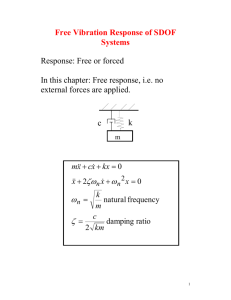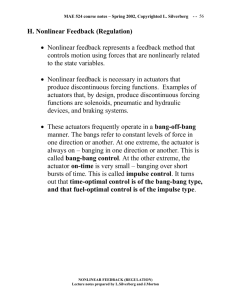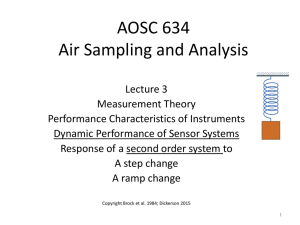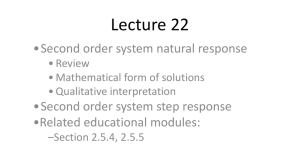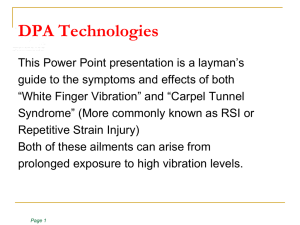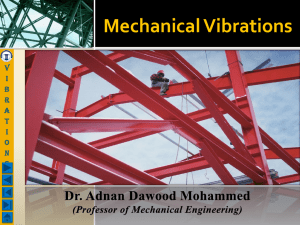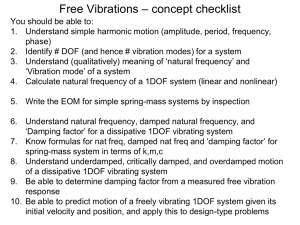II Single Degree of Freedom ( 1DOF ) Systems
advertisement
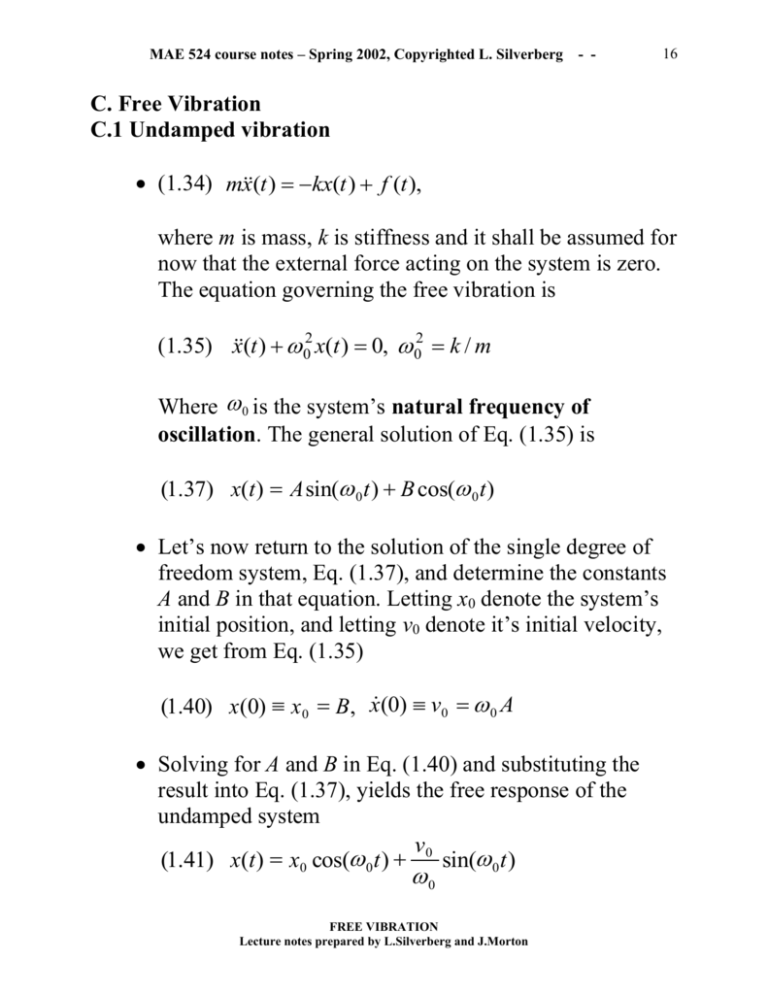
MAE 524 course notes – Spring 2002, Copyrighted L. Silverberg - - 16 C. Free Vibration C.1 Undamped vibration (1.34) mx(t ) kx(t ) f (t ), where m is mass, k is stiffness and it shall be assumed for now that the external force acting on the system is zero. The equation governing the free vibration is (1.35) x(t ) 02 x(t ) 0, 02 k / m Where 0 is the system’s natural frequency of oscillation. The general solution of Eq. (1.35) is (1.37) x(t ) A sin( 0 t ) B cos( 0 t ) Let’s now return to the solution of the single degree of freedom system, Eq. (1.37), and determine the constants A and B in that equation. Letting x0 denote the system’s initial position, and letting v0 denote it’s initial velocity, we get from Eq. (1.35) (1.40) x(0) x0 B, x (0) v0 0 A Solving for A and B in Eq. (1.40) and substituting the result into Eq. (1.37), yields the free response of the undamped system v (1.41) x(t ) x0 cos( 0 t ) 0 sin( 0 t ) 0 FREE VIBRATION Lecture notes prepared by L.Silverberg and J.Morton MAE 524 course notes – Spring 2002, Copyrighted L. Silverberg - - 17 C.2 Damped vibration (stable cases only) (1.42) mx(t ) cx (t ) kx(t ) f (t ), f (t ) 0 where c is the damping constant. Dividing Eq. (1.42) by m, yields Eq. (1.43). c k x(t ) 2x (t ) 02 x (t ) 0, , 02 . 2m m This time, let’s determine the solution by trying a solution in the complex form (1.44) x e st where s is a complex number. Substituting Eq. (1.44) st into Eq. (1.43), and dividing the result by e , yields (1.45) s 2 2s 02 0 Equation (1.45) is a quadratic equation with real coefficients. The solutions can be pairs of numbers that are complex, real multiples, or real distinct. FREE VIBRATION Lecture notes prepared by L.Silverberg and J.Morton MAE 524 course notes – Spring 2002, Copyrighted L. Silverberg - - 18 Underdamped (0) When 0, the quadratic equation (1.45) admits the two solutions 2 2 2 (1.46) s i, 0 Substituting Eq. (1.46) into Eq. (1.44), and invoking the principle of linear superposition (1.47) x(t ) A1e s1t A2 e s2t e t [ A1e it A2 e it ] e t [( A1 A2 ) cos(t ) i( A1 A2 ) sin( t )] e t [ A cos(t ) B sin( t )] where represents the system’s natural rate of decay, and denotes the system’s damped natural frequency of oscillation. The arbitrary constants in Eq. (1.47) are determined from the initial conditions. From Eq. (1.47) (1.48) x0 A, v0 A B The underdamped free response is (1.49) x(t ) e t [ x0 cos(t ) v0 x0 sin(t )]. FREE VIBRATION Lecture notes prepared by L.Silverberg and J.Morton MAE 524 course notes – Spring 2002, Copyrighted L. Silverberg - - Critically damped ( 0 ) When 0, the quadratic equation (1.45) admits the two repeated solutions (1.50) s1 s 2 t (1.51) x1 e t , x2 te By the principle of linear superposition, the general solution is (1.52) x(t ) e t [ A Bt ] where A and B are arbitrary constants. Substituting the initial conditions into Eq. (1.52) yields the critically damped free vibration response (1.53) x e t [ x0 (x0 v0 )t ] FREE VIBRATION Lecture notes prepared by L.Silverberg and J.Morton 19 MAE 524 course notes – Spring 2002, Copyrighted L. Silverberg - - 20 Overdamped ( 0 ) When 0 , the quadratic equation (1.45) admits two real solutions. 2 2 2 (1.54) s1 , s2 , 0 The general overdamped free vibration response is (1.55) x Ae s1t Be s2t e t [ Ae t Be t ] ( ) x0 v0 t ( ) x 0 v0 t e t e e 2 2 C.3 Comparison between limiting cases The undamped, underdamped, critically damped and overdamped responses, Eqs. (1.41), (1.49), (1.53), and (1.55), are identical to each other in limiting cases. The limits are lim (1.56) 0 sin( t ) t cos(t ) t 0 1 lim and (1.57) lim 0 et e t tet te t lim 2t. 0 1 FREE VIBRATION Lecture notes prepared by L.Silverberg and J.Morton
